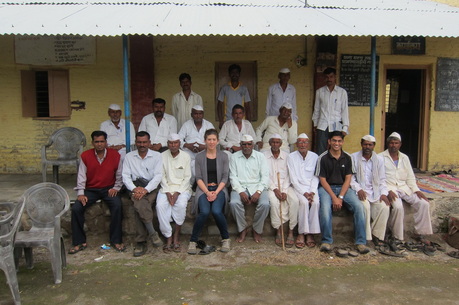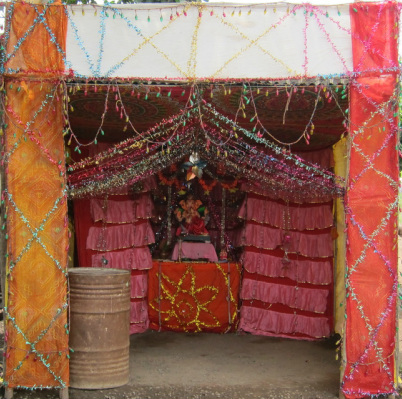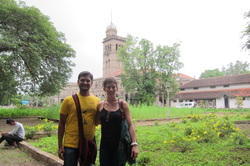
Wankute village farmers' meeting
After a three hour bus ride from Pune, my colleague, Arjuna, and I arrived at the Darewadi Training Center around 7:30 PM on Wednesday, September 19th. Darewadi is a village in the rain shadow region of Maharashtra and was one of the first watershed revitalization projects of the Watershed Organization Trust (WOTR). After the growing success of WOTR’s work, the organization eventually established the Darewadi Training Center to educate others about their methodology for participatory watershed management in drought stricken agrarian areas. The training center serves a model of sustainable development as it’s powered mostly by solar energy and is strictly vegetarian. Luckily, the dinner bell greeted us as we arrived – hot roti, rice, dal, vegetables, and a mango-custardy dessert which was incredible.
On the way from the bus stop to the training center, our WOTR driver informed us that the area had received barely any rainfall this year. Typically, annual rainfall in the area is roughly 420 mm, the vast majority of which is received during the monsoon season between June and September. This year, the area has only seen 290 mm and there’s only one week in September left. As most, if not all, villagers here make their living from agriculture, the drought is sure to have large impacts including a drop in crop yields and income. Our driver told us his family had to send one of his two sons to Pune to look for work. Luckily, his son was able to find a position with a company. Others would not be so lucky considering many do not speak English and do not have a college degree.
On Thursday, we visited two villages near Darewadi: Wankute and Kumbharwadi. These villages lie in the rain shadow or dry region of the famous Western Ghats – a mountain range in western India rich in biodiversity and also named a UNESCO World Heritage site. This area has always been drought prone but years of heavy deforestation, acute dry spells, and unsustainable agricultural practices have led to severe soil nutrient depletion and soil erosion. As a result, villagers could only cultivate a single crop for about 4-6 months – usually pearl millet or pulses – and were forced to find work as farm laborers or in sugarcane factories for the remaining 6-8 months of the year. Additionally, women were forced to walk hours to find suitable drinking water supplies and firewood. This instability also took its toll on children who, besides missing their parents, often could not attend school because they needed to help out at home.
It was hard for me to picture this when we arrived because today, both villages are incredibly green with tree-covered hillsides and acres of healthy-looking crops. WOTR has developed an innovative concept for working with villages that they call participatory watershed management. WOTR trains villagers in green infrastructure or landscape engineering treatments (e.g., farm bunds, dams, wells, and hillside terracing) and sustainable agricultural practices. Their process is completely dependent on the villagers who must volunteer their time and labor to install landscape treatments. They also have to keep livestock from grazing on certain forested areas as forests help reduce soil erosion and maintain groundwater supplies. This self-help component of WOTR’s work has been critical to their success. WOTR pays the farmers for their labor and, as a result, the farmers have the capacity to continue these efforts after WOTR leaves and make any needed repairs to natural and man-made watershed infrastructure. As the villagers were in need of employment, they faced no opportunity cost for their labor. WOTR also helps villagers navigate complex government subsidy programs for agriculture and watershed revitalization, which can help cover costs for farm equipment and drinking water.
The result: Farmers now grow both summer and winter crops and many have expanded their operations to grow cash crops such as pomegranate and tomato. In meetings with farmer groups, villagers proudly state how their children now have enough stability to attend school and stay in school, even through college. Women are more active in the community – they are earning their own income through livestock operations and have created 25 all-female “self-help” groups which serve as micro-lenders in the community. Marginalized tribal communities which reside the soil-poor hillsides are also seeing benefits including more opportunities to work as farm laborers.
After answering many of our questions, the conversation turned to more important topics highlighting challenges the village is now facing. Some of the farmers had heard about a new government program paying farmers to create large farm ponds to trap rainwater. Our guide, Prashant, a civil engineer for WOTR, warned the farmers that these were meant for certain agro-climatic zones and not their area. Government programs often promote one-size-fits-all solutions. Another issue is that farmers are eager to switch over more of their land to growing cash crops, specifically pomegranate. WOTR colleagues reminded the farmers that if everyone starts trying to sell the same crop the market will flood and the crop price will drop. Clearly, education is a huge part of working with these villagers who despite seeing the importance of watershed management and environmental conservation are still eager to increase their income.
To address some of the risks of climate change, specifically drought and weather fluctuations, WOTR employs a multi-barrier approach to water quantity provision with a new focus on climate change adaptation. In addition to their landscape treatments, sustainable agriculture work, and education efforts, WOTR now works with villages to promote water budgeting techniques and technologies (e.g., drip irrigation), agro meteorology installations to track weather patterns, and solar energy devices for cooking and lighting. These measures serve to secure water quantity in drought-prone areas and reduce the risk of using a green infrastructure approach to rural development. Additionally, this approach has multiple ancillary benefits such as improvements in biodiversity and habitat, carbon sequestration, improved air and water quality, and reduced soil erosion.
On the way from the bus stop to the training center, our WOTR driver informed us that the area had received barely any rainfall this year. Typically, annual rainfall in the area is roughly 420 mm, the vast majority of which is received during the monsoon season between June and September. This year, the area has only seen 290 mm and there’s only one week in September left. As most, if not all, villagers here make their living from agriculture, the drought is sure to have large impacts including a drop in crop yields and income. Our driver told us his family had to send one of his two sons to Pune to look for work. Luckily, his son was able to find a position with a company. Others would not be so lucky considering many do not speak English and do not have a college degree.
On Thursday, we visited two villages near Darewadi: Wankute and Kumbharwadi. These villages lie in the rain shadow or dry region of the famous Western Ghats – a mountain range in western India rich in biodiversity and also named a UNESCO World Heritage site. This area has always been drought prone but years of heavy deforestation, acute dry spells, and unsustainable agricultural practices have led to severe soil nutrient depletion and soil erosion. As a result, villagers could only cultivate a single crop for about 4-6 months – usually pearl millet or pulses – and were forced to find work as farm laborers or in sugarcane factories for the remaining 6-8 months of the year. Additionally, women were forced to walk hours to find suitable drinking water supplies and firewood. This instability also took its toll on children who, besides missing their parents, often could not attend school because they needed to help out at home.
It was hard for me to picture this when we arrived because today, both villages are incredibly green with tree-covered hillsides and acres of healthy-looking crops. WOTR has developed an innovative concept for working with villages that they call participatory watershed management. WOTR trains villagers in green infrastructure or landscape engineering treatments (e.g., farm bunds, dams, wells, and hillside terracing) and sustainable agricultural practices. Their process is completely dependent on the villagers who must volunteer their time and labor to install landscape treatments. They also have to keep livestock from grazing on certain forested areas as forests help reduce soil erosion and maintain groundwater supplies. This self-help component of WOTR’s work has been critical to their success. WOTR pays the farmers for their labor and, as a result, the farmers have the capacity to continue these efforts after WOTR leaves and make any needed repairs to natural and man-made watershed infrastructure. As the villagers were in need of employment, they faced no opportunity cost for their labor. WOTR also helps villagers navigate complex government subsidy programs for agriculture and watershed revitalization, which can help cover costs for farm equipment and drinking water.
The result: Farmers now grow both summer and winter crops and many have expanded their operations to grow cash crops such as pomegranate and tomato. In meetings with farmer groups, villagers proudly state how their children now have enough stability to attend school and stay in school, even through college. Women are more active in the community – they are earning their own income through livestock operations and have created 25 all-female “self-help” groups which serve as micro-lenders in the community. Marginalized tribal communities which reside the soil-poor hillsides are also seeing benefits including more opportunities to work as farm laborers.
After answering many of our questions, the conversation turned to more important topics highlighting challenges the village is now facing. Some of the farmers had heard about a new government program paying farmers to create large farm ponds to trap rainwater. Our guide, Prashant, a civil engineer for WOTR, warned the farmers that these were meant for certain agro-climatic zones and not their area. Government programs often promote one-size-fits-all solutions. Another issue is that farmers are eager to switch over more of their land to growing cash crops, specifically pomegranate. WOTR colleagues reminded the farmers that if everyone starts trying to sell the same crop the market will flood and the crop price will drop. Clearly, education is a huge part of working with these villagers who despite seeing the importance of watershed management and environmental conservation are still eager to increase their income.
To address some of the risks of climate change, specifically drought and weather fluctuations, WOTR employs a multi-barrier approach to water quantity provision with a new focus on climate change adaptation. In addition to their landscape treatments, sustainable agriculture work, and education efforts, WOTR now works with villages to promote water budgeting techniques and technologies (e.g., drip irrigation), agro meteorology installations to track weather patterns, and solar energy devices for cooking and lighting. These measures serve to secure water quantity in drought-prone areas and reduce the risk of using a green infrastructure approach to rural development. Additionally, this approach has multiple ancillary benefits such as improvements in biodiversity and habitat, carbon sequestration, improved air and water quality, and reduced soil erosion.


 RSS Feed
RSS Feed